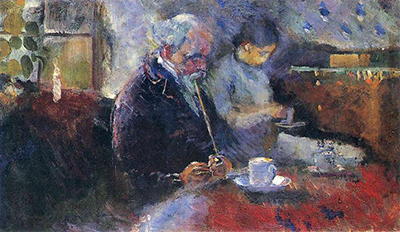Edvard Munch painted At the Coffee Table in 1883. This painting is approximately his one hundred and fifth. He was residing in Oslo in Norway, and pursuing an art course, after having defied his father's wishes of studying engineering.
During this time, Edvard was in close companionship with artists and writers of Kristiania Bohème, a movement that embraced naturalism and free love. He was twenty years old and still perfecting his craft in oil painting. Christian Krogh, one of the painters in Kristiania Bohème, reportedly mentored Edvard and inspired him to communicate his emotions through his art. At the Coffee Table employs the style of impressionism. It portrays a peaceful evening at the coffee table. The top left corner of the canvas shows a window painted in a blend of black, asparagus and white colors. By the window, lies a plant that has leaves stroked in green and olive colors.
The foreground of the canvas shows a grey-haired man wearing a dark coat and looking down as if reading something. In his hands, he holds a tobacco pipe. He is seated at a red coffee table, and his white cup of coffee seems untouched. A woman in violet stands beside him, holding a white coffee cup and saucer, and looking down as if placing them at the white bunch right below. Next to her, lies a cabinet painted in brown. Rays of sunlight shine through the window and hit the back of the man. They form a dark shadow below the window, the man's coffee cup, and to the right side of the woman.
Edvard's ability to portray real life as it happens is impeccable. Of the twenty to twenty-five canvases he painted in 1883, two are relatively similar to At the Coffee Table. The first one is At Supper, which portrays an aged man seating at a white table, next to two women. The second one is Around the Paraffin Lamp that shows an aged man and a young lad seating at a red table, that has a white lamp. Could these three pieces be communicating the same themes? Is the man in At the Coffee Table the same one in these other two? This kind of symbolism is probably why many enthusiasts call Edvard Munch, the father of expressionism. Edvard gave the At the Coffee Table painting to the county of Oslo. It is currently held at the Munch Museum in Oslo, Norway.




